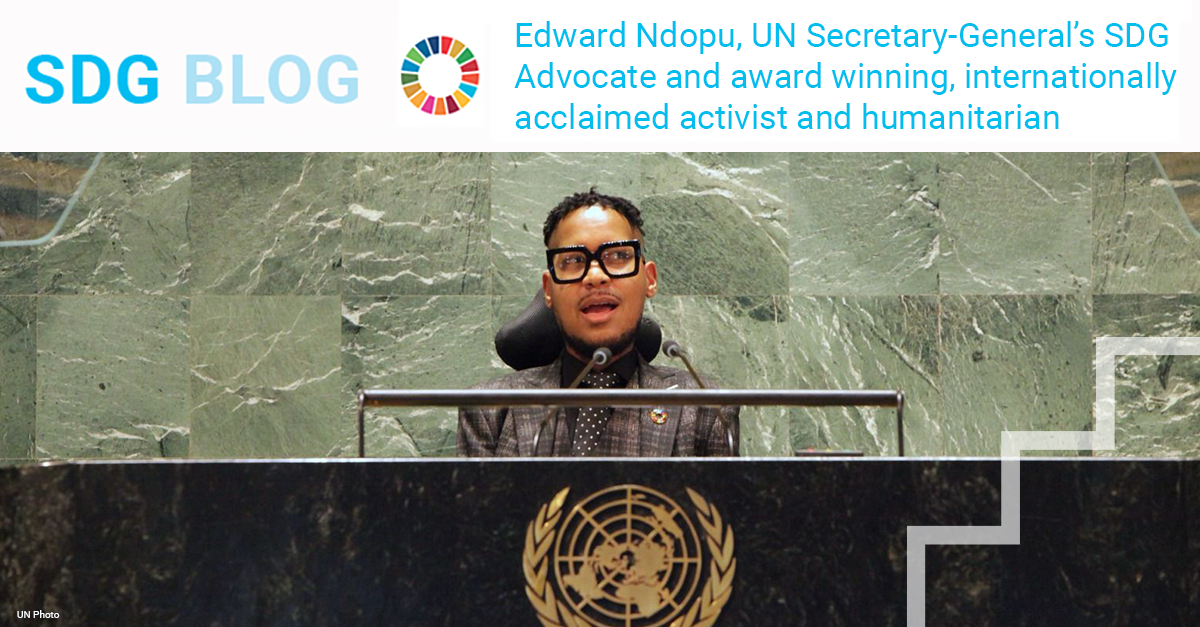SDG Blog

Centering disability justice in the fight for climate action
By Edward Ndopu, UN Secretary-General’s SDG Advocate and award winning, internationally acclaimed activist and humanitarian
In my exploration of the critical intersection between disability and climate change, I’ve had a profound realization: disability issues are not peripheral but central, crucial for innovative approaches in our collective fight against climate change. At this pivotal moment, the urgency for action is palpable, yet a significant piece is often missing from our climate dialogue. The experiences and needs of people with disabilities are frequently overlooked in policy discussions and sustainable practices. This omission is not just a gap in our approach; it’s a significant flaw. Those with disabilities face heightened risks in environmental disasters and extreme weather events, making their inclusion in climate action plans not just necessary but essential. My advocacy is for an inclusive approach to climate action, one that elevates the voices and needs of the disabled community, ensuring they are not an afterthought but key contributors in shaping a resilient, equitable future for our planet.
People with disabilities represent the world’s largest minority group, with over one billion individuals facing various physical, sensory, intellectual, and emotional challenges. Yet, their voices and leadership are often marginalized or ignored in climate discussions. It’s time to change that narrative and recognize that addressing the needs of people with disabilities is not just an act of inclusion; it’s a catalyst for innovation and progress in our fight against climate change.
Climate change poses a severe threat to all, yet its impacts are most acutely felt by vulnerable communities. Within these groups, people with disabilities are particularly at risk, facing unique challenges that often go overlooked. During extreme weather events such as hurricanes, floods, or heatwaves, standard evacuation plans and emergency response systems frequently fail to consider the needs of those with disabilities. This oversight can lead to dire consequences, with individuals with disabilities finding themselves stranded, unable to access safe locations due to the lack of accessibility features in emergency shelters or transport services.
Moreover, the escalation of temperatures associated with climate change can significantly worsen existing health conditions, particularly for those with disabilities. Heat stress, respiratory problems, and other health issues are exacerbated, necessitating that healthcare facilities not only be more accessible but also better equipped to cater to the specific needs of individuals with disabilities. This includes ensuring that medical equipment is accessible, staff are trained in disability awareness, and facilities are designed to be more inclusive.
The neglect of the needs of people with disabilities in climate change mitigation and adaptation strategies not only perpetuates existing inequalities but also undermines our collective efforts to address climate change. Inclusive climate action is essential, recognizing that protecting the most vulnerable among us strengthens resilience for everyone. By integrating disability considerations into climate policy, planning, and response, we can work towards a more equitable and effective approach to combating the effects of climate change, ensuring that no one is left behind in our quest for a sustainable future.
It’s essential to understand that when we prioritize the needs of people with disabilities, we create positive externalities that benefit society as a whole. Accessibility innovations, such as ramps, accessible transportation, and assistive technologies, are not just solutions for individuals with disabilities. They are innovations that enhance mobility, convenience, and safety for everyone. Take, for example, curb cuts on sidewalks, initially designed to aid wheelchair users but now appreciated by parents with strollers, cyclists, and delivery workers.
Moreover, the ingenuity within the disability community has led to groundbreaking inventions that have broader applications. Voice recognition software, initially developed for people with limited mobility, has transformed the way we interact with technology. Braille, developed for blind individuals, has evolved into a tactile reading system used by sighted people in various applications.
In the fight against climate change, this innovative potential must not be squandered. By involving people with disabilities in the development of climate solutions, we tap into a wellspring of creativity and adaptability. For instance, individuals with sensory disabilities have unique insights into the auditory and tactile aspects of our environment, which can inform early warning systems for climate-related disasters. Wheelchair users and individuals with mobility challenges can provide valuable input on accessible infrastructure design, making urban spaces more resilient to extreme weather events.
In my personal journey, I’ve seen firsthand how disability can spur innovation and resilience. As someone with a physical disability using a wheelchair, I’ve gained a profound appreciation for assistive technologies. These innovations, aimed at making the world more accessible, have not only revolutionized my life but also opened the door to numerous opportunities. They’ve enabled me to actively participate in education, employment, and advocacy, breaking barriers that once seemed insurmountable.
My experiences have led me to recognize that disability is a crucible for innovation, especially in tackling climate challenges. This perspective underscores the necessity of elevating the role and voices of people with disabilities in our climate action efforts. In doing so, we ensure that our journey towards a sustainable, inclusive future leaves no one behind.
In summary, disability is not a peripheral issue but a fundamental aspect of our society. People with disabilities, forming the world’s largest minority group, are uniquely affected by climate change. Addressing climate issues effectively requires us to recognize disability as a hub of innovation, where solutions tailored to the needs of individuals with disabilities yield broad benefits. By focusing on the leadership and insights of disabled individuals, we can drive progress and foster a more inclusive and resilient world for everyone. It’s vital to align the needs of people with disabilities with the urgent mission of climate action, benefiting their well-being and the betterment of society at large.
* The views expressed in this blog are the author’s and do not necessarily reflect the opinion of UN DESA.
 Welcome to the United Nations
Welcome to the United Nations